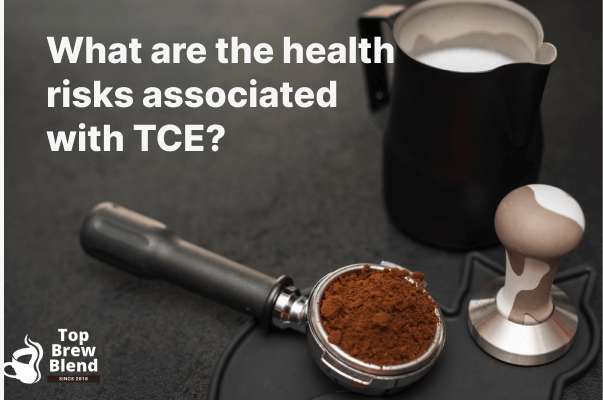What is TCE decaf coffee?

TCE decaf coffee refers to a decaffeination process known as the Triglyceride Process, which is a method used to remove caffeine from coffee beans. The name “TCE” doesn’t directly correspond to a standard decaffeination process, but let’s clarify the likely confusion and detail the process that might be referenced here.
The Triglyceride Process is a method that involves using coffee oils that have been extracted from spent coffee grounds. Here’s a simplified outline of how it works:
- Coffee Oil Extraction: First, the caffeine-rich oils are extracted from green (unroasted) coffee beans that have already been through a decaffeination process or from spent coffee grounds. This oil, which still contains some caffeine, is set aside.
- Soaking: The green coffee beans from which you wish to remove caffeine are soaked in hot water to expand the beans and open up their pores, making the caffeine within more accessible.
- Caffeine Removal Using Coffee Oil: The extracted coffee oil (from step 1) is then reintroduced to the soaked beans. Since this oil is naturally derived from coffee, it acts in a way that doesn’t significantly alter the beans’ flavor profile. The beans are then heated, which encourages the caffeine molecules to detach from the beans and bind to the molecules in the oil.
- Separation: After the caffeine has been absorbed by the oil, the beans are removed from the mixture. The decaffeinated beans are then dried, roasted, and packaged.
This method is considered more natural compared to other decaffeination processes, such as those using chemical solvents like methylene chloride or ethyl acetate, or the Swiss Water Process, which uses only water to decaffeinate the beans. The Triglyceride Process is valued for its ability to maintain the original flavor and quality of the coffee beans as much as possible while removing the caffeine.
Is TCE still used for decaffeinating coffee?
TCE, or Trichloroethylene, was historically used as a solvent in the decaffeination process of coffee. However, its use has been discontinued in the decaffeination process due to health concerns. Trichloroethylene is classified as a carcinogenic substance, and its exposure has been linked to increased risks of certain types of cancer. Consequently, the coffee industry has moved away from using TCE and other harmful solvents for decaffeinating coffee.
Today, several safer methods are employed for decaffeinating coffee, including:
- Water Process: This includes the Swiss Water Process and the Mountain Water Process, which use only water to remove caffeine from coffee beans without the use of chemicals. These methods rely on osmosis and filtration to extract caffeine.
- Carbon Dioxide Process: Also known as the Supercritical CO2 Process, this method uses carbon dioxide in a supercritical state to extract caffeine. It is efficient and can preserve the flavor of the coffee beans well.
- Solvent-Based Processes: While solvents are still used in some decaffeination processes, safer alternatives such as ethyl acetate (derived from fruit or sugarcane) and methylene chloride are chosen. These solvents have regulations regarding their usage and residual levels to ensure consumer safety.
Given the health risks associated with TCE, the coffee industry and regulatory bodies ensure that decaffeination processes are safe and do not pose health risks to consumers. The focus has significantly shifted towards methods that prioritize both the safety and preservation of coffee’s natural flavors.
What are the health risks associated with TCE?
Trichloroethylene (TCE) is a volatile organic compound that has been widely used as an industrial solvent for degreasing metals, as well as in adhesives, paint removers, and a variety of other products. However, its use has been significantly reduced or eliminated in many applications due to the health risks it poses. Research has identified several health risks associated with exposure to TCE, including:

- Cancer: The International Agency for Research on Cancer (IARC) classifies TCE as a Group 1 carcinogen, indicating that there is sufficient evidence to conclude that TCE is carcinogenic to humans. Exposure to TCE has been linked to an increased risk of certain types of cancer, including kidney cancer, liver cancer, and non-Hodgkin lymphoma.
- Neurological Effects: TCE exposure can affect the central nervous system, leading to symptoms such as headaches, dizziness, nausea, confusion, and coordination issues. Chronic exposure may result in more severe neurological conditions.
- Liver Damage: TCE can be toxic to the liver, leading to liver damage or hepatotoxicity. This can manifest as elevated liver enzymes, jaundice, or more severe liver conditions.
- Kidney Damage: TCE exposure is also associated with kidney toxicity, which can affect kidney function and lead to conditions such as renal tubular acidosis.
- Reproductive and Developmental Effects: Exposure to TCE can have harmful effects on reproduction and development. It has been linked to adverse outcomes such as miscarriage, congenital heart defects, and developmental neurotoxicity.
- Immune System Effects: Some studies suggest that TCE exposure may impact the immune system, potentially leading to autoimmune diseases or weakening the immune response.
Due to these health risks, the use of TCE in consumer products and in industrial applications has been highly regulated or phased out in many countries. Regulatory agencies, such as the United States Environmental Protection Agency (EPA) and the European Chemicals Agency (ECHA), have set strict guidelines and regulations to minimize human exposure to TCE and protect public health.
How can I tell if my decaf coffee was decaffeinated with TCE?
It’s highly unlikely that your decaf coffee was decaffeinated using Trichloroethylene (TCE), as its use for decaffeinating coffee has been discontinued due to health risks and regulatory actions. Modern decaffeination processes primarily use methods that are safe and have no health risks associated with them, such as the Swiss Water Process, the Carbon Dioxide Process, or solvent-based processes using substances like ethyl acetate or methylene chloride (both of which are considered safer than TCE).
If you’re concerned about how your decaf coffee was processed, here are steps you can take to ensure it was decaffeinated using a safe method:
- Check the Label or Product Description: Many coffee producers are transparent about the decaffeination process used for their products. Look for terms like “Swiss Water Process,” “CO2 Process,” “Mountain Water Process,” or “naturally decaffeinated,” which indicate safe, non-chemical methods of decaffeination.
- Research the Brand: Visit the coffee brand’s website or contact their customer service for information on their decaffeination process. Reputable brands are usually forthcoming about their methods and safety standards.
- Look for Certifications: Some decaf coffees come with certifications or labels that indicate the coffee has been decaffeinated using a specific process. For example, coffees decaffeinated using the Swiss Water Process might carry a specific logo or certification mark.
- Understand Regional Regulations: Being aware of the regulations in your country can also be helpful. In many countries, the use of harmful substances like TCE in food and beverage processing is strictly regulated or banned. Knowing these regulations can reassure you about the safety standards followed by coffee producers in your region.
- Choose Organic: Organic decaf coffee is less likely to have been decaffeinated using harmful chemical processes. Organic certification usually requires adherence to strict guidelines, including the types of substances that can be used in the decaffeination process.
Are there any safe alternatives to TCE decaf coffee?
Yes, there are several safe and widely used alternatives to TCE (Trichloroethylene) for decaffeinating coffee. These methods avoid harmful chemicals and offer consumers decaf coffee options that are safe and retain much of the coffee’s original flavor profile. Here are the primary methods:
- Swiss Water Process: This 100% chemical-free process uses only water to remove caffeine from coffee beans. It relies on solubility and osmosis to decaffeinate coffee beans, ensuring that the beans are 99.9% caffeine-free. The Swiss Water Process is highly regarded for maintaining the coffee’s flavor and aroma.
- Carbon Dioxide (CO2) Process: Also known as the Supercritical CO2 Method, this process uses carbon dioxide in a supercritical state as a solvent to extract caffeine from coffee beans. It’s effective and efficient, and because CO2 is a naturally occurring compound, this method is considered safe and environmentally friendly.
- Direct Solvent-Based Process Using Ethyl Acetate: Sometimes referred to as “naturally decaffeinated,” this method uses ethyl acetate, a compound found in fruits, as a solvent to remove caffeine. It’s considered safe and leaves minimal residue, and the solvents are removed from the beans after decaffeination.
- Indirect Solvent-Based Process Using Methylene Chloride: Although methylene chloride is a chemical solvent, when used in decaffeination, it is carefully controlled and the beans are steamed at high temperatures to ensure nearly all the solvent is removed. The residual levels are significantly below the limits that health authorities, such as the FDA in the United States, consider safe.
Among these methods, the Swiss Water Process and the CO2 Process are particularly popular for those who prefer completely chemical-free options. These methods are not only safe but also highly effective at preserving the coffee beans’ natural flavors and aromas.
Can decaf coffee still contain traces of caffeine?
Yes, decaf coffee still contains traces of caffeine, although the amount is significantly reduced compared to regular coffee. The decaffeination process removes most of the caffeine from the coffee beans, but it is not 100% effective in eliminating all caffeine. The specific amount of caffeine remaining in decaf coffee can vary depending on the method of decaffeination used, the type of coffee bean, and the brewing method.

Typically, an 8-ounce (240-milliliter) cup of decaf coffee can contain about 2 to 5 milligrams of caffeine, compared to approximately 95 milligrams in a similar serving of regular coffee. However, these amounts can vary, and some decaf coffees may have slightly more caffeine.
For most people, the small amount of caffeine in decaf coffee is not enough to cause a noticeable effect. However, individuals who are highly sensitive to caffeine or who must avoid caffeine for medical reasons should be aware that decaf coffee is not completely caffeine-free. For those looking to avoid caffeine entirely, it might be necessary to consider caffeine-free alternatives beyond coffee.
How does decaffeination affect the taste of coffee?
Decaffeination can affect the taste and aroma of coffee, although the extent of this impact depends on the method used for decaffeination, the quality of the beans, and the skill in roasting and brewing the decaf coffee. Here’s how decaffeination can influence the flavor profile of coffee:
- Flavor and Aroma Changes: The decaffeination process involves treating the coffee beans with water, solvents, or carbon dioxide to remove caffeine. This process can also remove some of the flavor compounds and oils that contribute to the coffee’s full taste and aroma. As a result, decaf coffee may have a milder flavor and less complexity compared to its caffeinated counterpart.
- Process-Specific Effects:
- Swiss Water Process and Carbon Dioxide Process: These methods are considered to be more gentle on the coffee bean’s natural flavors. They are less likely to significantly alter the taste and aroma of the coffee because they avoid harsh chemicals and instead use water or CO2 to extract caffeine. Coffee decaffeinated using these methods often retains a flavor profile that is closer to that of regular coffee.
- Solvent-Based Processes: Using solvents like ethyl acetate or methylene chloride can have a more noticeable effect on taste, potentially making the coffee taste slightly different from its caffeinated version. However, advances in these processes have minimized these effects, and many people find modern solvent-decaffeinated coffees to be quite palatable.
- Roasting and Brewing: The roasting process for decaf beans can also affect flavor. Decaf beans may roast differently than regular beans due to their altered physical and chemical structure after decaffeination. Roasters often adjust their techniques to compensate for these differences. Similarly, the brewing method can also impact the final taste, with certain methods better at extracting the full range of flavors from decaf beans.
- Quality of the Original Beans: The quality of the coffee before decaffeination plays a significant role in the taste of the final product. High-quality beans that have been carefully processed and decaffeinated are more likely to yield a delicious cup of decaf coffee that retains many of the desirable characteristics of caffeinated coffee.

